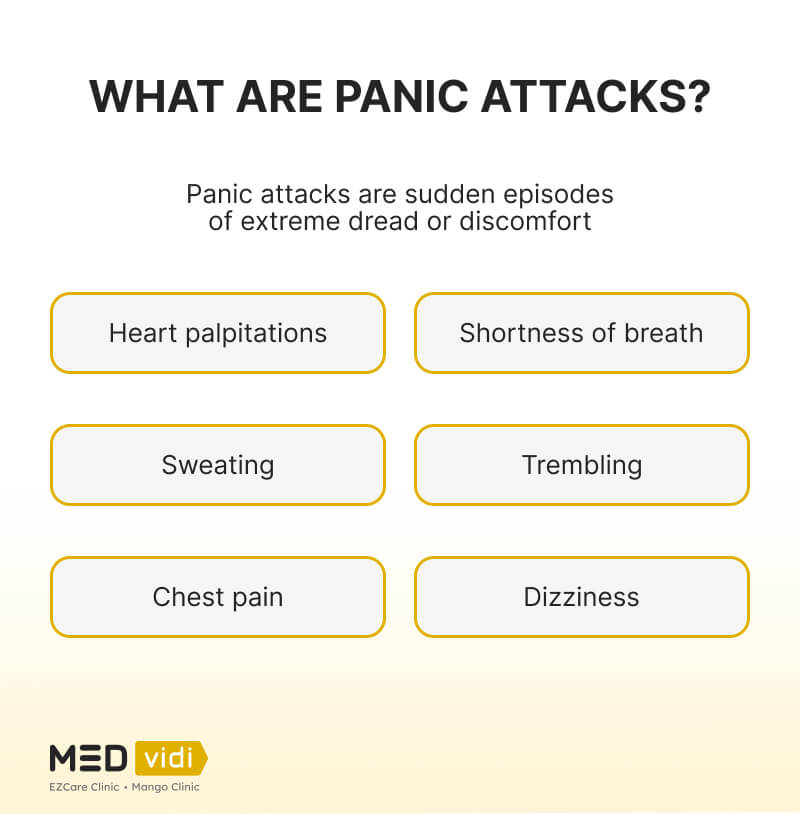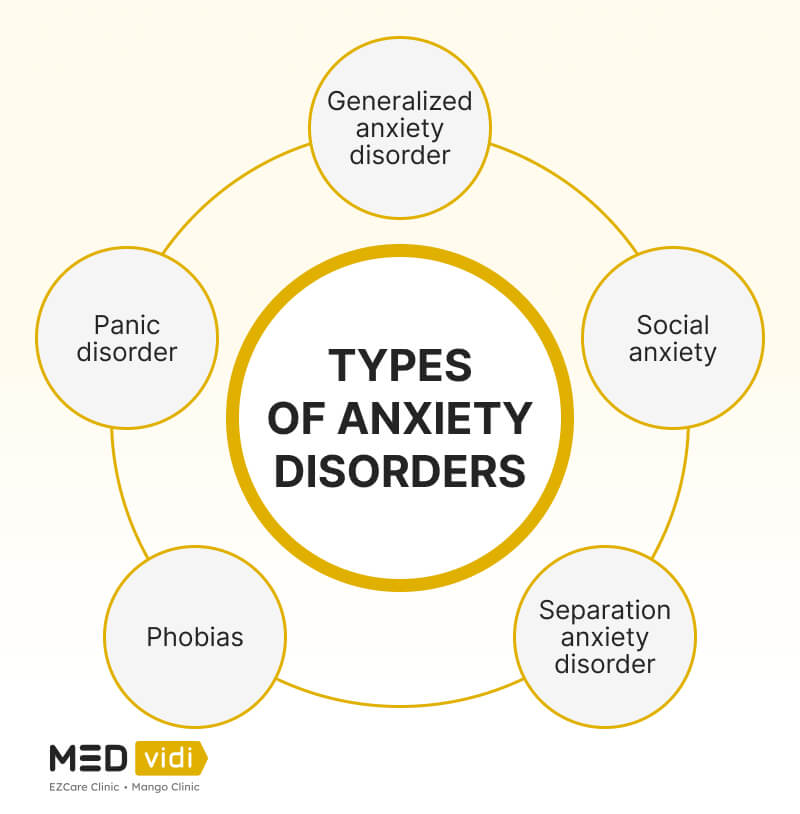Anxiety is a natural human emotion, an evolutionary response that helps us prepare for threats and defend ourselves. While feeling nervous now and then in stressful situations is normal,
Receive professional help to manage your anxiety.
Different Types of Anxiety: Diagnosis and Symptoms
Anxiety disorders are characterized by ongoing and severe anxiety, worry, or fear that may significantly hinder day-to-day functioning. However, different conditions also have unique signs. Common types of anxiety mentioned in the Diagnostic and Statistical Manual of Mental Disorders, 5th Edition (DSM-5) are explained below.
Generalized Anxiety Disorder (GAD)
Chronic and excessive worry or anxiety about various aspects of life is the hallmark of GAD. These worries may relate to work, health, family, or ordinary occurrences. In GAD, the anxiety is difficult to manage and is frequently accompanied by symptoms like:
- Restlessness.
- Fatigue.
- Muscle tension.
- Difficulty concentrating.
Panic Disorder
Panic disorder is characterized by unexpected and recurring panic attacks. They involve sudden episodes of extreme dread or discomfort. Symptoms associated with it include:
- Heart palpitations.
- Sweating.
- Trembling.
- Shortness of breath.
- Chest pain.
- Dizziness.
- The feeling of losing control.
- Fear of future panic attacks (leading to behavioral changes).
Social Anxiety Disorder (Social Phobia)
Social anxiety disorder is characterized by a strong fear of social situations. A person may also be afraid of being subject to scrutiny or unfavorable judgment. People who struggle with social anxiety may be anxious about:
- Public places.
- Speaking in public.
- Job interviews.
- Eating in public.
- Interacting with others in social settings.
Such fears can lead to avoidance behavior. Also, a person may become anxious about others noticing
Discuss your issues with mental health specialists at MEDvidi who can diagnose anxiety and provide personalized care.
Specific Phobia
A specific phobia is an extreme and irrational fear of a particular situation or thing, such as heights, spiders, flying, or medical procedures. The overwhelming fear causes avoidance behavior, which is distressing. When exposed to the triggering object or a situation, a person may experience:
- A sense of impending disaster or danger.
- The desire to run away.
- Heart palpitations.
- Sweating.
- Trembling.
- A sense of being choked or short of air.
Illness Anxiety Disorder
- A lot of anxiety regarding health.
- Avoiding persons or places out of concern for getting sick.
- Constantly looking up symptoms and diseases.
- Obsession with physiological processes like heart rate.
- Exaggerating signs and symptoms, such as when a cough seems to indicate lung cancer.
Agoraphobia
Agoraphobia is characterized by fear and avoidance of places or circumstances in which getting out might be challenging. A person may also avoid places where getting help might not be possible in the case of panic-like symptoms or other embarrassing or crippling symptoms. A patient may be afraid of using public transportation or joining open spaces crowds. Sometimes, one can fear being outside the home alone.

Separation Anxiety Disorder
Anyone with a separation anxiety disorder is anxious about being separated from significant others. The feeling remains for at least four weeks in children and six months in adults. The fear of separation goes beyond reasonable for the person’s age and interferes with daily functioning. A person with a separation anxiety disorder may refuse to leave the house without the loved person or spend the night without them, have nightmares about being separated, and be afraid of losing the person they love.
Selective Mutism
Usually starting before age five, selective mutism may not be recognized until the child starts school. Children with this condition do not communicate in specific social settings, such as school, but communicate well in familiar situations. Lack of speech can have consequences, including:
- Academic issues.
- Social withdrawal
- Extreme shyness
- Fear of being humiliated in public
- Extreme social anxiety
Many kids outgrow selective mutism; the condition may also go away for patients with comorbid social anxiety disorder. But sometimes symptoms can persist into adulthood.
Seek help and find support for anxiety management today!
Other Mental Health Conditions Related to Anxiety and Stress
There are significant similarities between anxiety and several other conditions, such as obsessive-compulsive disorder (OCD) and post-traumatic stress disorder (PTSD). While each disorder is different, they can share underlying reasons, experiences, and symptoms.
Obsessive-compulsive Disorder (OCD)
Obsessive-compulsive disorder (OCD) is a chronic mental illness that involves persistent, distressing thoughts (obsessions) and repetitive actions (compulsions) performed in response to obsessions. These thoughts and actions can be distressing and time-consuming and greatly disrupt daily living. When it comes to examples of obsessions and compulsions, a person may be afraid of germs or infections and that is why cleans everything many times. Another case is an urge for symmetry and specific order.
Post-traumatic Stress Disorder (PTSD)
Someone who experienced or witnessed a traumatic event may later develop post-traumatic stress disorder. It can affect people of all ages and is frequently linked to experiences of war, violence, mishaps, natural disasters, or any other occurrences that pose a threat to one’s life.
Symptoms:
- Intrusive memories.
- Avoidance.
- Negative changes in thoughts and mood.
- Increased arousal.
- Emotional numbing.

Skin-picking (Excoriation Disorder)
Excoriation disorder, or
- Compulsive skin-picking.
- Attempts to stop this behavior but struggling to do so.
- Emotional distress.
Hair-pulling (Trichotillomania)
Trichotillomania is characterized by an overwhelming impulse to pull out hair, which results in hair loss and emotional distress. This condition is characterized by body-focused repetitive behavior (BFRB), like skin-picking. The symptoms include compulsive hair-pulling as a response to a buildup of tension or anxiety.
Conclusion
Anxiety is a complex and diverse spectrum of mental health conditions that can profoundly impact daily life. Every type of anxiety disorder has its unique challenges and requires personalized treatment. It’s important to understand that anxiety disorders are real medical problems, not just a sign of weakness. If you experience prolonged or severe anxiety or other related symptoms, consider consulting healthcare professionals at MEDvidi to establish an individual treatment plan.
FAQ
What are the 3 common symptoms of anxiety attacks?
Anxiety attacks are characterized by different physiological and psychological symptoms. The most common ones include:
- A feeling of immense dread or nearing doom.
- Palpitations or an accelerated heartbeat.
- A sense of choking or shortness of breath.
What are the different forms of anxiety attacks?
Anxiety attacks can be expected and unexpected. Expected anxiety or panic attacks mean that a person knows what causes them, such as certain situations or objects. Unexpected panic attacks, on the other hand, seem to happen without a reason—in reality, the reason exists but is difficult to identify.
What does an anxiety attack look like?
The symptoms of anxiety attacks might vary, but typical ones include:
- Physical symptoms like sweating, trembling, lightheadedness, chest pain, and experiencing hot or cold flashes.
- Emotional signs include intense fear, losing control, or a feeling of impending doom.
- Behavioral signs, such as pacing, restlessness, or needing confirmation from others.
Are there 4 levels of anxiety?
There is no established framework for dividing anxiety into four stages. However, anxiety can be categorized according to its impact on everyday functioning or severity, including mild, moderate, severe, and panic-level anxiety.
What is the most common anxiety type?
Generalized anxiety disorder (GAD) is the most prevalent type in this class. It is characterized by persistent and excessive worry about different areas of life, including work, health, family, and daily situations.
What is the disorder category of anxiety?
Anxiety is a mental health disorder classified as an “Anxiety Disorder” in the Diagnostic and Statistical Manual of Mental Disorders, 5th Edition.
Is anxiety a mental illness or disorder?
Anxiety is a disorder as well as a mental illness. It encompasses a wider range of illnesses that impair functioning and cause distress by affecting a person’s thoughts, feelings, and behaviors.













